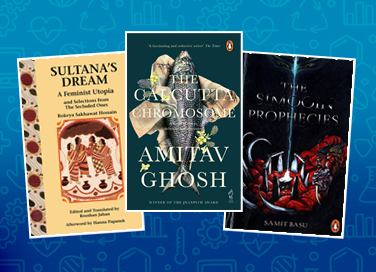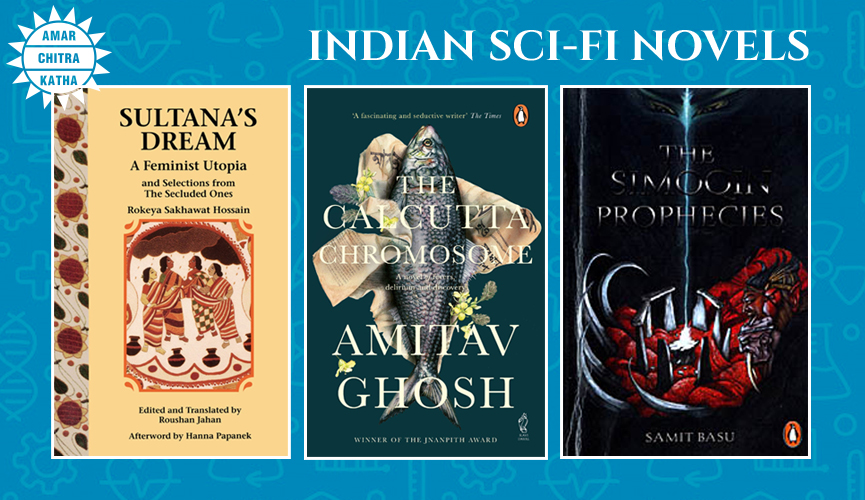Popular Indian Science Fiction Novels
- April 21, 2021


Popular Indian Science Fiction Novels
- April 21, 2021
By Mehar Dhillon
The science fiction genre is evidence of the infinite potential of the human imagination. The unique human ability to weave ideas and stories around things that we have never seen, touched or smelled is reflected in this genre. It is a genre of speculative fiction, containing imagined elements absent from our world, and often encompasses stories that revolve around otherworldly elements such as space and time travel, galactic exploration, extraterrestrial life forms, parallel universes, technological and scientific developments and their subsequent consequences. Thus, science fiction, or sci-fi as it is popularly called, is rightfully cited as the literature of ideas.
While the genre has still not been explored thoroughly in India, we still have many sci-fi gems to offer. Here are some of the most popular Indian science fiction books.
To receive more such stories in your Inbox & WhatsApp, Please share your Email and Mobile number.
Sultana’s Dream by Begum Rokeya
Sultana’s Dream is about a woman that is transported into Ladyland, where being a woman is to be privileged and free and to be a man is to shut in and shackled. It is a piece of parallel universe science fiction literature, written by Rokeya Sakhawat Hossain in 1905. The story follows the protagonist as she wakes up in Ladyland and is slowly introduced to its lore and laws. This story was revolutionary for its time and reveals the logical fallacies in the arguments supporting the way of the patriarchy in a witty and humorous manner. It peels back the patriarchy’s veneer of disliking anything ‘frivolous’, that only barely hides its actual disdain for everything ‘feminine’. Rokeya explores the condition of Indian womanhood by juxtaposing it with the liberated life the women of Ladyland live. Sultana’s Dream may justly be considered regressive by today’s standards of feminism, however, it is important we acknowledge that it was conceived during a time when feminism was in its beginning stages and women weren’t given even a fraction of the rights as they are today.

The Calcutta Chromosome by Amitav Ghosh
The Calcutta Chromosome is a medical science fiction thriller written by Amitav Ghosh, in 1995 and received the Arthur C. Clarke award. Ghosh brilliantly braids the characters within each other’s lives as we follow each of them through a mix of different timelines, making the plot incredibly complex and intricate. We, as readers, follow the enigmatic L. Murugan on his search for the ‘Calcutta Chromosome’. His deep fascination with the Nobel Prize–winning scientist, Ronald Ross, who found out that malaria is spread through mosquitoes allows him to unearth an underground movement that has the potential to grant eternal life. The Calcutta Chromosome’s various twists and turns ensure a captivating and thrilling reading experience.
The Simoqin Prophecies by Samit Basu
The Simoqin Prophecies is the first novel in the GameWorld trilogy, it is followed by The Manticore’s Secret and The Unwaba Revelations. The story revolves around the realization of two prophecies, the first one foretelling the rise of great rakshas ‘Dahn Gem’ and the subsequent prophecy that comes as a beacon of hope that reveals a hero would arise to defeat Dahn Gem. The story follows the hero as he is faced with a moral dilemma, where he must commit terrible acts in order to save the world from the rakshas.
It is written by Samit Basu and was published in 2004. It is a kaleidoscopic mix of eastern and western mythical elements beautifully blended to create an enthralling universe that enchants the readers and makes them invested in the series.
Oftentimes, the genre is reduced to a means for escapism rather than being the effective social tool it has proven to be over the years. Pioneering authors of this genre have used it as protest literature, usually in the form of dystopian world stories. These stories highlight the pressing issues of our time that are slowly turning into the norm and turn our attention to the problems we have the privilege to divert our gaze from in order to retain our comfort. Science Fiction or Sci-Fi, through the efforts of authors like Begum Rokeya, Amitav Ghosh and Samit Basu, continue to inspire our ‘sense of wonder’ and provide us with much-needed glimpses into dystopian futures that could become reality.
To receive more such stories in your Inbox & WhatsApp, Please share your Email and Mobile number.

Comic of The Month
The Naval Journey of India Book I
This book is the first of a three-book series that takes a deep and detailed look at India's Naval History and a deep insight into the lives of our men and women in white. But any series on the Indian Navy has to start at the very beginning - exploring India's celebrated maritime history. Join our little hero, Bharat, and his grandfather, Commodore Sagar, as they sail into the deep blue waters of time. Book I of The Naval Journey of India takes a sweeping look at India's maritime endeavours, how the seas impacted us over millennia and how the oceans made us who we are.